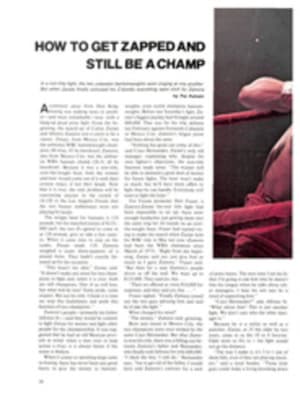
NOW YOU CAN BE THE FIRST PERSON ON YOUR BLOCK TO ICE-SKATE ON WHEELS
It's the Hans Brinker obsession, the irresistible urge to put on a pair of skates and glide silently across the crystalline ice while your breath forms clouds in the frosty air, the need to cut figure eights while a healthy red glow spreads across your cheeks. Only it's 95° outside and the lake, which freezes over every November, has been bone dry for two months. It looks like a burial ground for old inner tubes. Your last resort, the local Ice Palace, which you discover is closed to the public unless, of course, you want to count the Middle Eastern folk-dancing class that has squatter's rights until next winter. Of all the winter sports that melt away with the snow, ice skating has always been at the top of my list.
But that was before Ralph Smith of Los Angeles got cracking. In 1967, while he was doing classified antisubmarine-warfare research in Southern California, Smith got to thinking about inventing an ice skate that wouldn't require ice, and before long iceless skates, later to be called BiSkates, had become his passion. Finally, in 1972, he quit his job and started dreaming up ways to substitute wheels for blades. (This wasn't the first time Smith had acted so impulsively. In 1956 he quit work on the Falcon missile so that he could spend his time "thinking" about Einstein's theory of relativity.)
It took Smith almost five years and some 25 modifications to come up with a two-wheel roller skate (one wheel in front, one in back), which he felt simulated the feel of ice skating. His BiSkate will do just about anything the ice skater wants it to do, down to Three Turns, Mohawks and even the tough jumps and turns (although a skidding stop is impossible). Esthetically, the BiSkate is no prize. With its caramel-colored plastic wheels, it looks as though a mad baker had attached two glazed doughnuts to the bottom of a hockey boot and left them to petrify. BiSkates cost up to $80, which is perhaps not excessive considering that good roller skates—the kind with four wheels—go as high as $200. Smith's skates are sold through mail order from RLS Products, Box 799, Santa Monica, Calif. 90406. So far he has sold only 103 pairs. But he is sanguine. "When General Motors announces an increase in car sales," he says, "they mean a couple of million. When I announce an increase, it means two pairs."
To practice BiSkating, it is best to begin at a roller rink, ignoring the commotion your BiSkates will cause. It's not easy to be a two-wheel person in a four-wheel world. At first, the traditional roller skater will see you as some strange mechanical mutant and, in a way, you are. The earliest roller skates were more than likely two-wheel affairs, which appeared sometime in the 18th century as substitutes for ice skates. But soon roller skates became much as we know them today and headed off in a direction of their own. So by eliminating two wheels, Smith, one might say, has rolled the evolution of the ice skate backward at least two centuries.
Ice skating on wheels instead of a blade may give one a sort of unicorn feeling—that is, making do with one horn. However, there are bigger problems that come under the general heading of equilibrium. Two wheels are as hard to balance on as a blade. (Compared to BiSkates. roller skates are as easy to maintain your balance on as a bicycle with training wheels.) The minute you lurch onto the floor you'll feel as though the world had suddenly come to a point and there you are tottering on it. Take a deep breath, ignore that 14-year-old smart aleck who buzzes by with a cheery "You dropped a couple of wheels!" and commence gliding—or rather staggering—around the rink. With your arms flailing in front of you and your body doing an exotic shuffle, accept the fact that you look like someone in the advanced stages of terminal charley horse. But, if you've had any ice-skating experience, that will be an advantage, and you'll soon get the hang of it. And you're in for a big surprise. To the outside world you may still look like some sawed-off roller skater, but in reality you are ice skating on wood. Top that. Dorothy Hamill!
Let's assume that you have mastered the technique. Now you're faced with another problem. As you glide along, you become aware for the first time of the loud disco music in the background, and the roller skaters seem to be doing a strange rubber-legged dance that is known as "rexing." Ice skaters usually feel more at home with selections on the Hammond organ and waltzes. Suddenly you understand that BiSkates are a passport to instant culture shock; even worse, to split personality. Mixing the worlds of roller and ice skating can't be tolerated forever. Ice skating at a roller rink is like playing miniature golf at Pebble Beach. Unless you want to undergo a severe identity crisis, your best bet is to clear out immediately and search for a vacant lot where there're just you and the breeze. (You might want to wear earplugs because, on concrete. BiSkates make a sound that is disturbingly reminiscent of a train rattling over a bridge.) Now all you have to do is put on a scarf and mittens and, with a leap of imagination, you're sailing along the pristine ice of a secluded New England lake. In the distance you can almost see children riding a toboggan, jolly revelers skating at your elbow. But be sure to watch out for the empty beer cans.

